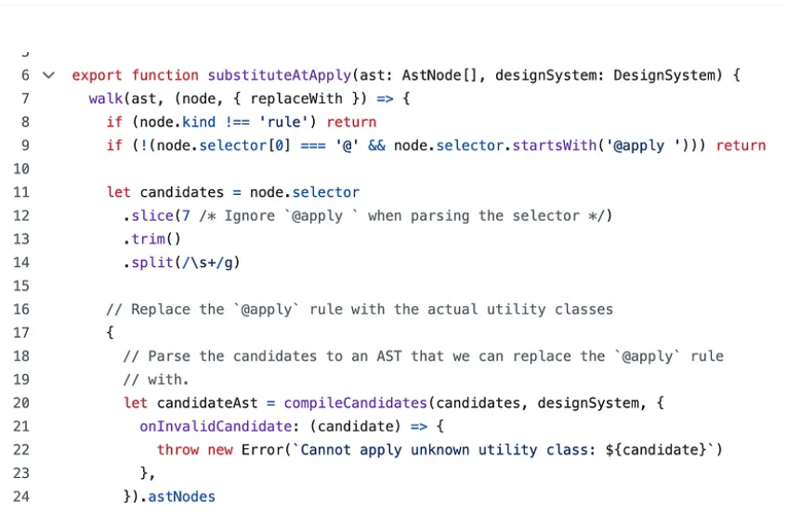Home >Web Front-end >JS Tutorial >How Tailwind CSS detects circular dependancy.
How Tailwind CSS detects circular dependancy.
- Patricia ArquetteOriginal
- 2024-10-09 06:19:02769browse

In this article, we analyze error thrown in substituteAtApply. This error is about circular dependency detected.
walk(rule.nodes, (child) => {
if (child !== node) return
throw new Error(
`You cannot \`@apply\` the \`${candidate}\` utility here because it creates a circular dependency.`,
)
})
This is a high level overview of the code around this error.
walk — recursive function:
Let’s begin with walk:
export function walk(
ast: AstNode[],
visit: (
node: AstNode,
utils: {
parent: AstNode | null
replaceWith(newNode: AstNode | AstNode[]): void
context: Record<string, string>
},
) => void | WalkAction,
parent: AstNode | null = null,
context: Record<string, string> = {},
) {
for (let i = 0; i < ast.length; i++) {
let node = ast[i]
// We want context nodes to be transparent in walks. This means that
// whenever we encounter one, we immediately walk through its children and
// furthermore we also don't update the parent.
if (node.kind === 'context') {
walk(node.nodes, visit, parent, { …context, …node.context })
continue
}
let status = visit(node, {
parent,
replaceWith(newNode) {
ast.splice(i, 1, …(Array.isArray(newNode) ? newNode : [newNode]))
// We want to visit the newly replaced node(s), which start at the
// current index (i). By decrementing the index here, the next loop
// will process this position (containing the replaced node) again.
i -
},
context,
}) ?? WalkAction.Continue
// Stop the walk entirely
if (status === WalkAction.Stop) return
// Skip visiting the children of this node
if (status === WalkAction.Skip) continue
if (node.kind === 'rule') {
walk(node.nodes, visit, node, context)
}
}
}
walk is a recursive function located in ast.ts.
It calls itself recursively when node.kind === ‘context’ or when node.kind === ‘rule’, breaking condition is based on status
// Stop the walk entirely if (status === WalkAction.Stop) return // Skip visiting the children of this node if (status === WalkAction.Skip) continue
Now let’s zoom out a bit and study the code in the vicinity of walk function in apply.ts
// Verify that we don't have any circular dependencies by verifying that
// the current node does not appear in the new nodes.
walk(newNodes, (child) => {
if (child !== node) return
// At this point we already know that we have a circular dependency.
//
// Figure out which candidate caused the circular dependency. This will
// help to create a useful error message for the end user.
for (let candidate of candidates) {
let selector = `.${escape(candidate)}`
for (let rule of candidateAst) {
if (rule.kind !== 'rule') continue
if (rule.selector !== selector) continue
walk(rule.nodes, (child) => {
if (child !== node) return
throw new Error(
`You cannot \`@apply\` the \`${candidate}\` utility here because it creates a circular dependency.`,
)
})
}
}
})
TailwindCSS authors have added explaining comments across the codebase where required or it makes sense to provide additional context
with comments.
About us:
At Think Throo, we are on a mission to teach the advanced codebase architectural concepts used in open-source projects.
10x your coding skills by practising advanced architectural concepts in Next.js/React, learn the best practices and build production-grade projects.
We are open source — https://github.com/thinkthroo/thinkthroo (Do give us a star!)
We also provide web development and technical writing services. Reach out to us at hello@thinkthroo.com to learn more!
References:
https://github.com/tailwindlabs/tailwindcss/blob/next/packages/tailwindcss/src/ast.ts#L70
https://github.com/tailwindlabs/tailwindcss/blob/c01b8254e822d4f328674357347ca0532f1283a0/packages/tailwindcss/src/apply.ts
https://stackoverflow.com/questions/71669246/need-help-using-apply-directive-in-tailwind-css
https://github.com/tailwindlabs/tailwindcss/issues/2807
The above is the detailed content of How Tailwind CSS detects circular dependancy.. For more information, please follow other related articles on the PHP Chinese website!
Related articles
See more- An in-depth analysis of the Bootstrap list group component
- Detailed explanation of JavaScript function currying
- Complete example of JS password generation and strength detection (with demo source code download)
- Angularjs integrates WeChat UI (weui)
- How to quickly switch between Traditional Chinese and Simplified Chinese with JavaScript and the trick for websites to support switching between Simplified and Traditional Chinese_javascript skills

